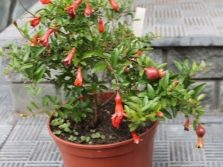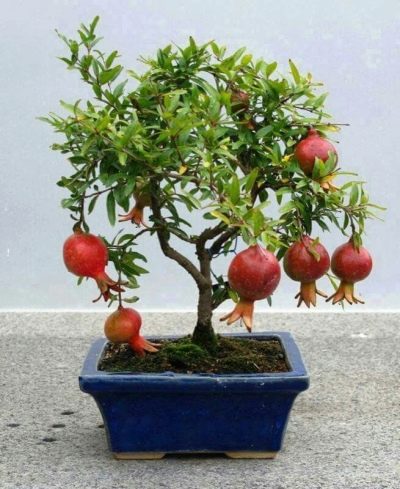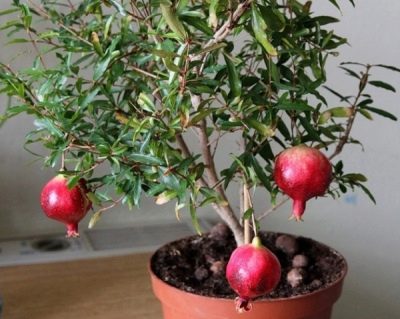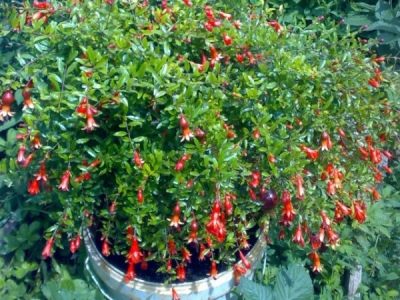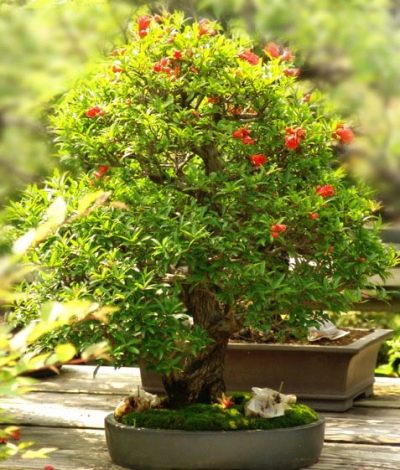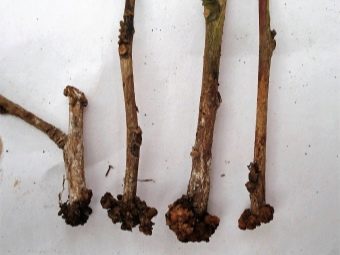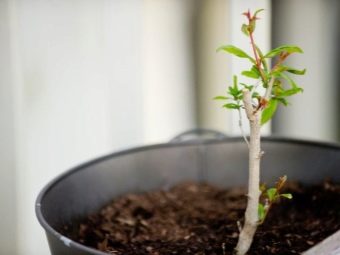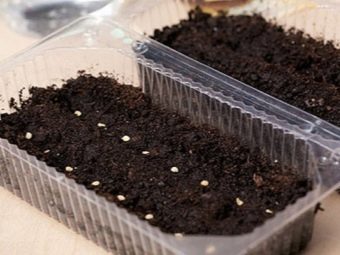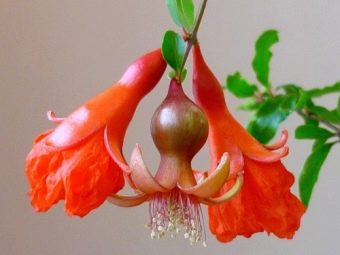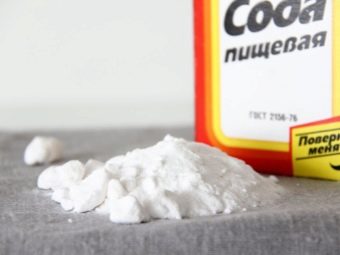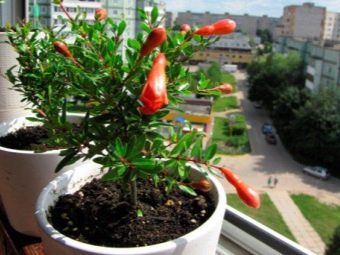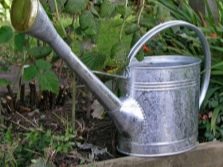Growing indoor pomegranate and rules of care for him
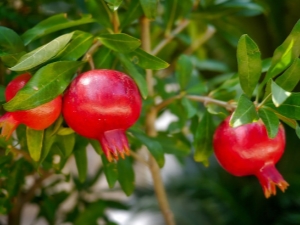
Pomegranate is a tropical fruit familiar to everyone since childhood, featuring a bright taste and attractive appearance.Many people like to use it fresh, others are happy to drink the juice from it, and surely all these people would not refuse to grow such a plant even in their own backyard, but the climate does not allow.
However, few people know that it is possible to grow pomegranate even in the conditions of an ordinary apartment. In this case, the main goal will be all the same interior decoration, however, the fruits will also be, albeit very small.
Special features
A full-fledged pomegranate tree in the conditions of an apartment will not be able to grow, if only because it doesn’t fit there, but this does not mean that crop-growers will have to give up. The fact is that there are numerous varieties that differ from an ordinary plant with a height not exceeding one meter. Together, these varieties are called dwarf pomegranate.
In fact, it remains a subtropical plant, but in nature it grows in the mountains, where it is not so hot, so the conditions of an ordinary apartment triple it completely, especially since there are no special requirements for the soil either.
Such a shrub is very popular from a decorative point of view, because pomegranate does not just bloom with unusual flowers, but also offers at once two of their varieties on each bush. Some of the flowers look just like water lilies, more precisely, resemble them in shape - they are responsible for flowering and fruiting, and in one such flower there is a pistil and a stamen. Those flowers that look like bells do not imply any practicality, except for a decorative look, they are asexual, therefore they are not suitable for fruiting. Regardless of the form, all pomegranate flowers have a bright red color and relatively elegant size - no more than 3 centimeters in diameter.
With regard to the collection of fruits, it is necessary to clarify: not all types of dwarf pomegranate fruit. Even if the fruiting is still present, you should not expect that the volumes will be large - they correspond to the size of the plant, because the entire harvest will be enough just to get enough a couple of times.
The number of fruits from one bush is relatively small (usually not more than 10 pieces), and although in appearance and taste they do not differ much from those in the store, an unprepared gardener may disappoint their size - they do not exceed 6 centimeters in diameter.
Types
As befits a cultivated plant that is actively grown throughout the world, ornamental dwarf pomegranate is represented at once in several varieties, each of which has its own characteristic features. Some of them may be decisive for individual gardeners, because all the main varieties should be considered in more detail. At the same time, all dwarf varieties, without exception, are distinguished by the fact that, unlike garden ones, they do not shed leaves for the winter, while remaining evergreen.
"Nana" - probably the most common variety, which is very popular. This indoor scrub does not differ from the full-fledged absolutely nothing, except for sizes not exceeding one meter in height. At the same time, the attractiveness of the plant becomes evident much earlier, because it starts to bloom before reaching maximum growth - at a height of 40 centimeters it gives the first flowers. No wonder this variety is considered a complete copy of the original - like an ordinary garden pomegranate, it bears fruit. In short, we can say that most of the descriptions of the advantages of a miniature pomegranate belong specifically to this variety.
"Baby" and "Carthage" - very common and very similar to each other varieties, characterized by even greater dwarfism. Traditionally, they grow to a height of not more than half a meter, they are valued for larger and more abundant flowers. Fruiting is present, but it is possible not earlier than in the second year of the plant’s life.
“Uzbekistan” is the only grenade in this list that is not classified as a dwarf, but at the same time it is distinguished by a relatively small height (no more than two meters), and therefore it can grow in apartment conditions. For obvious reasons, it requires high ceilings and considerable space, but it will please fans to enjoy the fruits much more than any of the above varieties.
"Ruby" - a variety up to 70 cm, is found relatively infrequently, but is highly valued for the very characteristic color of flowers.
Some gardeners try to grow garden varieties right in the apartment from the seeds of fruits bought on the market. The famous "Bonsai" is so unlikely to grow, because the fruits are usually collected from plants of hybrid varieties, but in many cases the planted grain still germinates. Most likely, it will not have all the same features that the mother plant possessed, precisely due to hybridity.
You should not be afraid that a bush unsuitable for limited conditions will grow to unprecedented sizes - a small tub restricting the root system will simply not allow the grenade to become excessively large.
How to multiply?
People, first caught fire with the idea of growing a pomegranate bush right in the apartment, usually come up against such an idea after seeing a vivid example of successful cultivation. If you have seen such an example somewhere with your friends, then it is best not to invent complicated methods of reproduction, but to dissolve the plant by cuttings.
Producing cuttings is not year-round. Half-woody twigs are usually removed approximately in July, whereas fully lignified cuttings should be collected in February. Internets in the amount of four pieces for each cutting must be left. At the same time, semi-woody shoots take root much better, but gardeners often feel sorry for them, because in the middle of summer they traditionally have an attractive decorative appearance. As for lignified shoots, they take root even more than once, so for a more likely achievement of the result, it is worth spending on a root stimulator.
Rooted pomegranate stalk in water or a special sandy-peat (in equal proportions) substrate, which must be well moistened.
If primer is used, the cutting should be buried approximately 2-3 knots in it, and the potential sprout should be located not vertically, but at an angle of 45 degrees.
Since the future bush still belongs to subtropical, rooting requires a ground temperature not lower than 23 degrees - for this the container with the substrate is covered with an airtight film and placed on the solar window sill. It should be remembered that even a short or slight deviation from the specified temperature regime can prevent the germination of the cutting.
However, care for the handle does not end there. Although the pomegranate does not put forward any special conditions for the quality of the soil, it is very picky about moisture - if the earth dries out at least for a while, the undelayed cutting may die.
Although the film helps to maintain the desired temperature, it prevents the plant from breathing, because every day it is necessary to slightly uncover the ground in order to provide ventilation.
If all the conditions were provided correctly, after a week or two the cuttings will give the first roots, however, the full growth of the root system is achieved only after a month. When your own buds appear on the handle, you can simplify care a little, by refusing to hide the foil, but regular watering should be continued, ensuring that the soil in the tank does not turn into a swamp. When the first shoot appears, its upper third is removed — thanks to this, the plant begins to branch.
How to grow?
Very often, a potential gardener does not have such acquaintances who can share a pomegranate cutting, but he found out about the very possibility from the Internet or special journals and firmly set himself the idea of growing such a bush. To do this, it is not even necessary to look for an opportunity to buy a sprout - if you strictly follow all the instructions, you can even grow a real pomegranate from the stone of a fruit bought in a store. To sow the seeds correctly, you need to figure out how to do it.
The growing procedure is rather complicated, but a patient person will certainly cope. First you need to understand that you can only plant fresh seeds, because there is no way to store them for a long time. This means that planting issues should be dealt with immediately after the fruit that gave the seeds has been eaten.
It would seem that nature specifically gives the fruit pulp so that it feeds the seeds in the process of rotting; however, in the case of pomegranate, the pulp must be removed - it begins to rot, it will provoke seeds rotting in the ground. Peeled grains must be soaked in water for a day so that they are not fully drowned.
Even if the dwarf pomegranate is planned to be planted not literally at home, but in the garden, planting seeds for a start is not in open ground, but in a pot - if only because January or February is considered the optimal time for planting. Such terms are justified by the fact that for a good growth of the plant it is necessary to plant it in the open land at the beginning of summer, and for this it is necessary that the sprout is pre-strengthened.
In any case, the seeds are buried slightly in the ground - about an inch. As in the case of propagation by cuttings, it is very important to maintain the necessary conditions for irrigation - the soil must be wet all the time, but it is unacceptable to re-moisten the soil. Temperature not below room temperature is also a prerequisite - a subtropical guest should feel no worse than it would be at home.
The seeds germinate approximately in half a month, after which they are recommended to provide maximum natural heating - for this, pots with sprouts are set on the windows, preferably on the sunny side of the building. After a couple of months, leaves will appear on the best seedlings, but those sprouts that have developed insufficiently can be removed at this point so that they do not interfere.
If the seedlings have already got at least three pairs of full-fledged leaves, then it's time to plant them in separate containers so that they no longer interfere with each other. Approximately from May, it is permissible and even necessary (if the weather permits) to take the pots of seedlings out into the street - there the pomegranate will receive more natural conditions for growth.
At the same time, contrary to the expectations of many newcomers, young grenades are highly undesirable to leave directly in the open sun - in some cases the result will be burns on the surface of the plants. For this reason, for the location of the pots, it is better to choose shaded places that are protected from strong sun. If the seedlings are all good and they have survived until the autumn, they should be put back into the room, it is permissible even in a cool place. Right up to the beginning of the next spring, they are rather picky about their location, but as early as March it is necessary to put them on the windowsill again, and towards the end of the spring - take them out to fresh air.
The flowering of a homemade dwarf pomegranate is possible already in the first year of life, but experienced gardeners recommend stopping this process immediately, simply cutting flowers. Such a young plant at this moment is still not sufficiently developed for reproduction and fruiting, so if you allow it to bloom, it will negatively affect growth. Even in the second year of life, flowering is desirable to significantly limit.
If you are expecting fruits, then you will have to wait even longer - several years depending on the variety and the correctness of compliance with our instructions. It should be noted that, in general, pomegranates grown from kernels develop much more slowly than similar bushes planted from cuttings, therefore flowers and fruits will appear on average somewhat later.
In addition, one should not think that if the eaten fruit, which gave the seeds, was tasty, then the grenades that grew in the future will be the same - on the contrary, they would rather differ markedly for the worse.
Top dressing and protection against diseases
The life cycle of a pomegranate is divided into two alternating periods: active growth in the warm season and the so-called rest - in the cold. During the period of active growth, it is recommended to fertilize the plant approximately every two weeks.
The best fertilizer for pomegranate is, of course, a complex mineral purchased at a specialty store. However, at home it is possible to feed the bush with animal waste, especially if the pomegranate is planted after all not indoors, but in the fresh air. For such purposes, suitable as a mullein in a ratio of 1: 10, and fermented chicken manure, which is prepared according to a special scheme. To do this, mix 1/3 of the litter with 2/3 of water and leave it in a warm place for 2-3 weeks in a tightly closed container, and then sequentially dissolve one part of the mass in 25 parts of water. The use of both “homemade” fertilizers is most practical immediately after watering.
In addition to the fertilizers described, it is necessary to resort to the help of other chemical agents whose task is to protect the garnet from diseases. The most typical problem is powdery mildew, for which the optimal conditions will be the lack of regular ventilation in a damp room or unstable temperature. With a good reaction rate at the initial stage, the illness can be eliminated by treatment with a special composition of 5 grams of soda diluted in a liter of water and mixed with soap. If the powdery mildew has reached the advanced stage, fungicides can not be avoided - “Topaz” or “Skor”, “Khom” or any other similar means will do. In this case, it is very important to maintain the necessary concentration, for which it is worth carefully studying the instructions.
Pests are also not indifferent to the dwarf grenade, and in this case it is also very appropriate to notice the problem in time. If the scale of infection is still small, the whitefly or aphids (usually they infect this plant) can be collected even by hand or with a vacuum cleaner. To get rid of eggs laid, you should use ordinary soapy water, which carefully wipe the leaves on both sides.
Keep in mind that both the insects themselves and their eggs can fall into the pot during the processing process and survive in the ground there, because the ground must always be covered with plastic or any other film before disinsection. Chemistry will have to be resorted to only in critical cases - then it is worth buying the drugs "Aktara" or "Karbofos", "Fitoverm" or "Aktellik".
Some problems and diseases of pomegranate are associated not so with pests or bacteria, as with the wrong growing conditions - respectively, the issue is not solved with the help of any drugs, but by returning to normal conditions. For example, garnet often has branch cancer, accompanied by cracking of the bark and the formation of swelling of the spongy structure, which is often the result of mechanical damage.
There are no means to stop the development of the disease, because you just have to remove the affected areas - often this leads to a strong reduction of the crown, and sometimes does not help at all, but there is no alternative. There are perhaps preventive measures to protect against illness, which consist in protecting the plant from severe frosts and mechanical loads.During the pruning (for any purpose) it is necessary to use only really sharp tools, otherwise it can also cause cancer.
It also happens that the leaves of the shrub appear brown or yellow spots - in this case, it is usually suspected excessive soil moisture. When growing in a pot it will be enough just to reduce the amount of moisture and the frequency of watering, but when planting a pomegranate in the garden it is better to transplant. A transplant is also good because it opens up the root system, and if rotten parts are visible there, the diagnosis is confirmed. Such rotten roots must be ruthlessly removed so that only healthy tissue remains, and all cuts must be covered with a thin layer of crushed charcoal.
How to care?
Home care for pomegranate consists of numerous steps, each of which, however, does not constitute anything complicated. First you need to choose a good place for the plant, in which it will receive a sufficient amount of sunlight and heat. In the house, he should stand at the windows facing south, and in the summer he is completely taken out onto the street.
In the first days on the street, the pomegranate is afraid of a too bright sun, which has become unusual for him over the winter, because initially it is hidden in the shade, but after a few days it is exposed directly to the sun - there it will be good for him. If the grenade does not provide the sun and light, it will drop the leaves and lose any decorative effect.
Dwarf varieties of pomegranate, bred specifically for decorative purposes, the leaves usually do not shed, or shed their leaves in part. At the same time, they also need a period of rest - for the winter time, the plant is provided with a cool climate and relatively scarce watering so that the bush can take a break from the active growing season.
In summer, garnet feels best at a temperature of about 24-26 degrees Celsius. But in the winter he literally needs 10-12 degrees. Having sustained at least a month the plant in such coolness, the gardener lays the conditions for large-scale flowering and fruiting, in other words, for the tree this is a very useful moment. It is important not to overdo it, because at temperatures below 6 degrees Celsius heat may die.
Pomegranate needs much water; in the summer period, it needs to be watered up to two times a week, without sparing water. At the same time, the pomegranate does not like the marshland, so that the gardener's excessive generosity can provoke yellow-green leaves and root rot. If the plant is planted in a pot, choose a pot so that the drainage in it is good. As for winter, for this period the pomegranate becomes much less “greedy”, because they water it more rarely, watching only that the earth around it does not dry out completely.
Although the pomegranate loves heat, in fact, it transfers it with difficulty, therefore leaf spraying will be very useful in the summer. For this purpose, a soft, slightly warmed water capable of imitating warm summer rain is desirable. Spraying should be done at least twice a week, and even more often with strong heat, otherwise the leaves dry and curl. In winter, this procedure is not necessary.
Pruning needed pomegranate as an ornamental plant, characterized by rapid growth. As a sample, choose the shape of a classic bush or stam tree. For a dwarf grenade will be enough four or six main branches, but the extra should be cut off. The remaining selected branches are also shortened as necessary, and so that they are not intertwined, the number of internodes on each branch is limited to five.
In addition to the regular, special spring pruning of the pomegranate is also carried out, when in March everything superfluous is removed, including shoots at the roots, vertical and just dry shoots. At the same time, it is important not to prune last-year-old ripe shoots, because only they are tied with fruits, so you should remember which branches have already been bearing fruit, and which ones have not yet.
To learn how to grow a pomegranate, see the following video.





